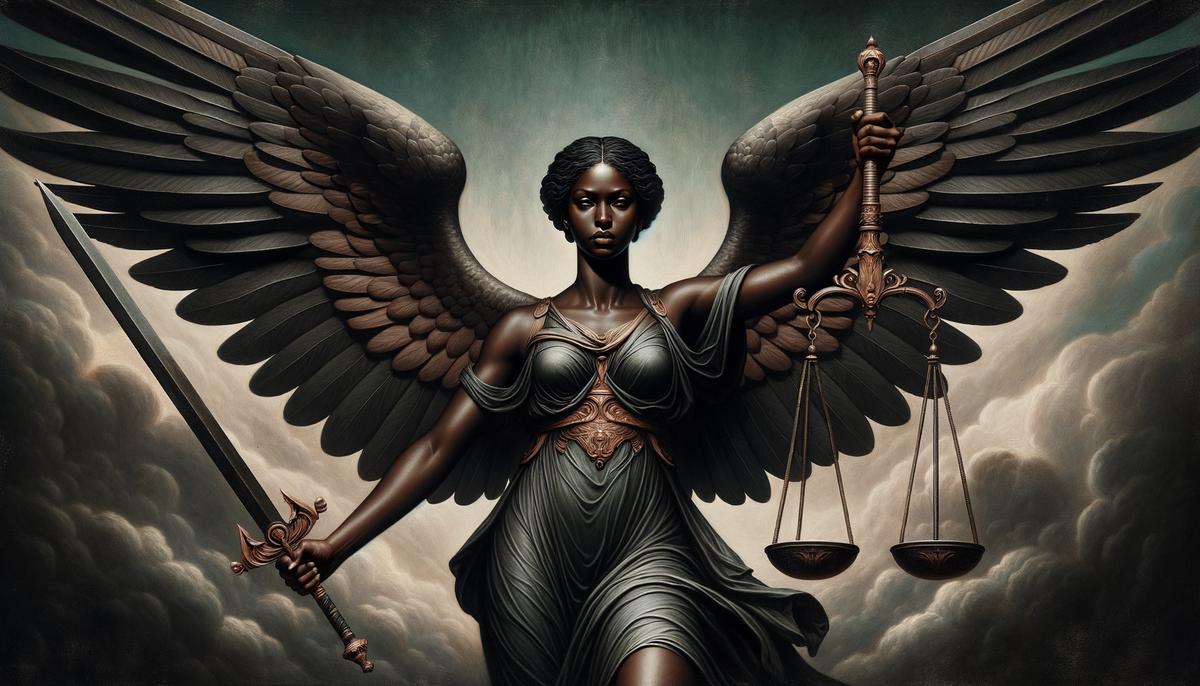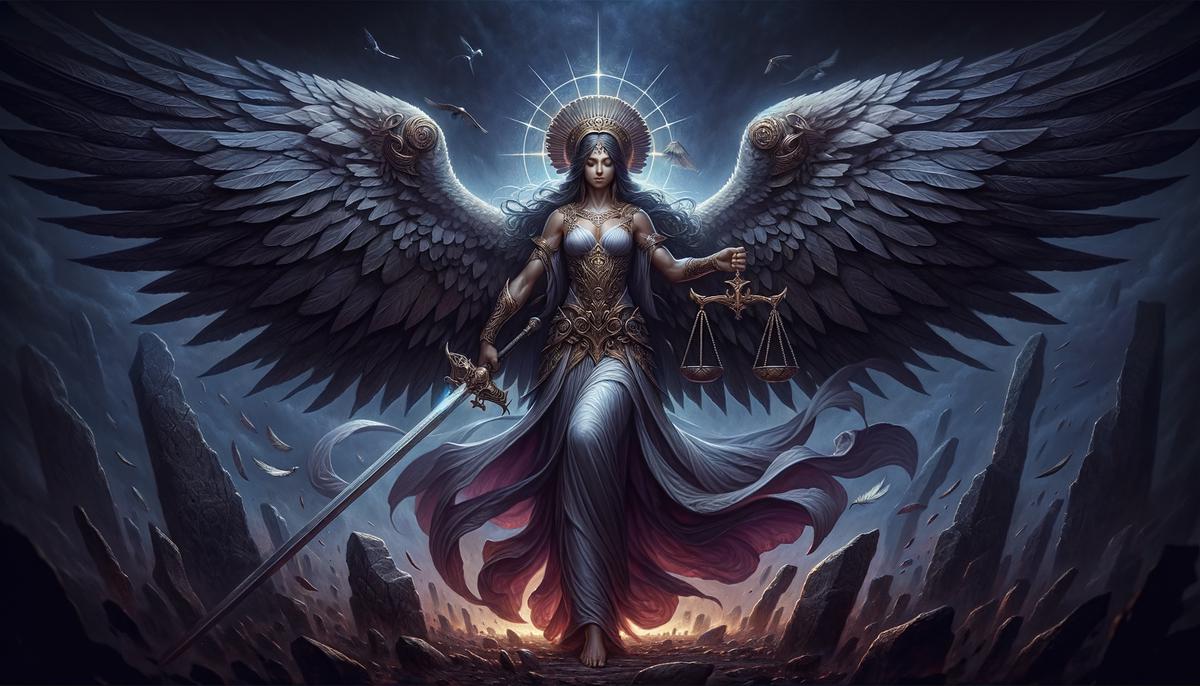Wading through the annals of Greek mythology, we often encounter figures that are as complex as they are captivating. Nemesis, the goddess of retribution, stands out not just for her role in maintaining cosmic balance but also for how her stories resonate with timeless themes of justice and consequence.
Origins and Family
Nemesis, revered as an enforcer of moral justice, has origins rooted in the dark embrace of night. Acclaimed as the daughter of Nyx, the primordial embodiment of night, her lineage ties her to a brood of cosmic entities personifying various aspects of the human condition and natural phenomena. This connection with Nyx embodies the inevitable and impartial nature of Nemesis's role in delivering justice.
Beyond her primary association with Nyx, the myths venture into various narratives, weaving together a tapestry of parentage that enhances her enigmatic aura. Other traditions suggest more complex origins, hinting at figures like Erebus, the personification of deep darkness, or even Oceanus, the Titan ruling the earth-surrounding river, as potential fathers. Each potential lineage enriches her mythos, casting a broader net over her jurisdiction in matters of human morality and cosmic order.
Exploring her celestial family tree grants us sharper insights into Nemesis's nature. Co-siblings under Nyx include Thanatos (Death), Hypnos (Sleep), and the Moirai (Fates), each a formidable force within Greek mythology. Like her siblings, Nemesis governs an essential aspect of human existence, emphasizing the intrinsic balance between life's fortunes and adversities.
This lineage not only shrouds her in the mystique of night but also aligns her function as both a vindicator and a symbol of universal equilibrium. The vast range of her familial connections adds notable dimensions to the essence of retribution she is meant to dispense—the intricate threads of justice she weaves tie directly into the core principles embodied by her kinfolk. By embracing such a diverse heritage, she stands not merely as a punisher, but as a guardian ensuring that the scales of fortune and retribution maintain their delicate balance amidst the capricious fates spun by her own siblings.
Nemesis and Justice
Nemesis wasn't one to let the high and mighty climb too high without a reality check. Known as the dispenser of dues and the embodiment of divine retribution, she held a specialized role in the pantheon of Greek godly duties—essentially, she was the cosmic "I told you so." While other gods were busy throwing lightning or mixing up potions, Nemesis kept her eyes on the prize, making sure that each mortal or divine entity got exactly what was owed to them.
One can imagine Nemesis, with her grand wings flapping in the ethereal winds, sword and scales in hand, zooming around to discourage anyone considering stepping over the line. These attributes are as significant to her iconography as a superhero's cape. The sword represented her decisive judgment, splitting right from wrong. The scales are an unmistakable symbol of justice; balanced and unbiased, just like modern depictions in courtrooms. And those wings allowed her to administer her universal brand of swift justice efficiently, ensuring that no transgression against divine law went unnoticed.
Her accountability tours were quite the sight. Picture this: a deity with a diadem sternly adjusting her scales while reminding mortals and immortals alike of the perils of hubris. Stories are riddled with examples of proud characters who got their comeuppance through Nemesis' machinations. Narcissus, that good-looking fellow who couldn't get enough of his reflection, likely didn't reckon his obsession would lead to a fantastic cameo opportunity for Nemesis. In watching his unending vanity, Nemesis led him to a pool which became his lover and grave—a poetic yet tragic example.
Imagine being the mythical entity whose job it was to keep gods and mortals in check. Cutting down inflated egos must've been in her job description right under "must-have stellar flight skills." No wonder she remains one of the most potently symbolic mythological figures: an enduring emblem of inevitable consequence serving cosmic justice with winged determination. She didn't let anything slip.
In essence, Nemesis personified the stark intuition that excess unchecked fosters decay and downfall. Her very presence an omen to those overly blessed with fortune or confidence, Nemesis thrived within a unique mythic niche; she was a constant celestial reminder that too much of a good thing stung worse than rejection. Interestingly, the dose of humility she served preserved not just order but the essential cosmic fairness deeply woven throughout the threads of Greek mythology. Quite the custodian, that Nemesis.

Iconography and Worship
When it comes to the visual fanfare of ancient icons, Nemesis doesn't skimp on the symbolic accoutrements. This divine figure remains a staple model of retributive justice found in every "mythology markets best" catalog. Just reflect on that iconic getup—from her all-important apple branch, which symbolizes the fruit of wisdom and perhaps, a reminder of the bitter taste of comeuppance, to the wheel, which like any good justice-warrior's toolkit, symbolizes the cycle of fortune, beholden to turn unfavorably when arrogance spins out of control.
Speaking of reins and wheels, the bridle isn't just for centaur management—it's symbolic gold! For Nemesis, this represents control and restraint, metaphysical items necessary to rein in human hubris just before it races recklessly into divine displeasure.
Over in Rhamnus, northeast of Athens, devoted followers had quite the time setting up one of her sanctuaries—a big deal considering its age. Here dwelled one of her most significant statues; a splendid sculpture believed to have almost been an Aphrodite. Picture this: clad in simple dress, possibly composed as part of a makeover, due to originally being planned for Aphrodite herself. And right there, Nemesis stood, depicting the gravity essential to her justice-dealing duties. Crowned with a regal stag-themed tiara flanked by subtle wing designs—they meant business back then!
The temple itself, reflecting her role fully, wasn't just any old tourist stop. The folks at Rhamnus took Nemesis seriously, embracing her vital role in keeping cosmic karma on an even keel. Pilgrims swung by to pay their respects, likely contemplating which of their past deeds could use a smidge more humility under Nemesis's stern gaze.
Illustrated on vases and reliefs, where she either doled out cosmic justice or quest essentials, Nemesis whisked about, represented frequently as mobilized justice. With a solemn dignity in posture, she personified the awe-inspiring might that convincingly warned every fortune-tipping mortal or deity about the boomerang nature of ill-deserved prosperity.
Between sanctifying temples with her cosmos-coherent justice league credentials and appearing at the eternal swag meet of mythology with her every statuette and symbolic trinket, Nemesis pretty much set the gold standard for "balance or bust!" Who wouldn't revere a deity whose main gimmick was making sure everyone got exactly what they deserved? She was not just mythological governance but also a stalwart safeguard against divine and mortal overreach—an ancient celebrity in moral equilibrium, penned down for ages as the epitome of mythological moxie!
Mythological Tales Involving Nemesis
Zipping through Olympus and sliding into mortal realms, Nemesis made herself known not just as a celestial bouncer checking egos at the door but also as a narrative staple in the tales that have trickled down through ancient whispers. Her mythic accounts shine a spotlight on the twisted tango of fate and the thin ice of hubris—adventures that confirm "what goes up must come down, often in grand mythical style."
Interactions with none other than Zeus, the head honcho of Olympus, position Nemesis as more than Olympus' moral meter maid. According to myth, Zeus, smitten by Nemesis's no-nonsense aura and timeless stoic grace, put on quite the effort to woo her. Nemesis, however, wasn't one to swoon so easily and transformed into various animals trying to dodge Zeus's godly charms. Eventually, she transformed into a goose. Undeterred, Zeus turned into a swan in what can only be typified as the avian form of, "Oh, it's on now!" The chase culminated in Nemesis relenting and together, eggs were made; those mystical eggs later produced Helen of Troy and the twins Castor and Polydeuces (Pollux)1. This intense myth underscores not just peculiar parental optics but also paints how even dimensional deities weren't immune to inter-divine drama and how fate uses Olympus' own antics as teaching moments for humans orbiting under their chaotic celestial dome.
Segueing from divine progeny and mythical soap operas, one of the juiciest pieces of Nemesis-baked humble pie was served to Narcissus. This was a lad so fetchingly handsome that mirrors probably sighed in unreciprocated adoration. However, smug about his looks, Narcissus played it cool, snubbing admirer after admirer. Enter Nemesis, equity's eagle-eyed watchbird and karma's artisan on duty. Displeased with his vanity, Nemesis directed him to a reflecting pool—an irresistible sight for someone so smitten with their own reflection. Spellbound by his image, Narcissus tipped into the ironic demise of drowning in his own superficiality, absorbed in his watery selfie too deep for any heart's rescue2. This moral nugget neatly wraps up how Nemesis manages to clinch her retribution toolkit, pinning stark reminders across the human-celestial tapestry that vigor without virtue finds little favor and less fortune in fate's unsmiling eyes.
Such mythological whirlwinds exploit prime avenues into the essence of Nemesis: highlighting dualities of fortune twisted with inevitability, concerns swirling about retribution tweaked with a brush of poetic symmetry. Each tale, each whisper of her wings, propounded a central Grecian gig—a caution woven into humanity's roadmap guiding against the arrogance carpooling craftily alongside achievement and success.
Through swirls of myth and undying devotion to metaphysical implacability, Nemesis transcends as the undiluted essence of "ancient checks and balances," scripting spiraling lessons spanning hubris, justice, and the gambling tables of divinity. In these entertaining, if cautionary vignettes, she uncompromisingly brokers universal equity—one bear-sized divine intervention at a time.

Nemesis's Modern Legacy
Nemesis's transformation from a mythological figure to a ubiquitous symbol of inescapable justice is impressive for a goddess who doesn't appear as frequently as her Olympian peers. Over time, her legacy has woven its way through literature and popular culture, taking a prominent role in modern tales of downfall—from movies to everyday gossip.
Her name signifies poetic—and often ironic—justice, permeating our stories. The significance that Nemesis held for the Greeks persists today, deeply ingrained in storytelling culture. In literature, from Mary Shelley's Frankenstein to Nathaniel Hawthorne's The Marble Faun, characters face their "Nemesis"—seeing grand ambitions crumble under the weight of guilt and ethical missteps. Each narrative echoes the presence of Nemesis, teaching timeless lessons: tread carefully and make fewer mistakes.
In film and television, Nemesis adds a theatrical twist, keeping audiences engaged. From comic book superheroes grappling with seemingly unconquerable adversaries to cinematic epics where dreamers face harsh realities, Nemesis spices up the plot, reminding everyone that hubris never goes unnoticed.
Her iconic status has also seeped into our everyday language. To mention one's "nemesis" today is to acknowledge a formidable challenge or intense rivalry, whether in sports, academia, or corporate competition. It's a nod to the idea that wrongdoers eventually face consequences.
Nemesis's influence extends to discussions of justice and fairness. Her presence is felt in legal matters, ensuring that balance is restored and heroes navigate the complexities of human interactions. She quietly presides over courtrooms, a subtle reminder of the scales of justice.
As literature's unforgiving matriarch, Nemesis shapes narratives that underscore the consequences of misfortune. Her echo resonates through centuries-old tales and modern retellings, guiding the narrative toolkit. Whether viewed through a serious or entertaining lens, her presence amuses and instructs, shaping the figures within her stories.
So, be mindful, future storytellers and proud jesters alike, from the heights of mythological discourse to the whispers of cinematic cult-dialogue: every creator crafting nemesis-shaped tales pays homage to the enduring power of balance and the inevitability of justice. Nemesis, framed within anecdotes shared across time, remains an immortal force, weaving possibilities into the fabric of our collective imagination.
In the grand tapestry of Greek mythology, Nemesis serves as more than a harbinger of retribution; she embodies the profound truth that every action invites its own measure of response. Her legacy, woven through myths and modern interpretations, reminds us that the scales of justice, though ancient, still hold sway in the moral compass of human affairs. Nemesis remains not just a mythological figure but a perennial symbol of the balance that is as crucial today as it was in the times of Olympus.

Photo by tingeyinjurylawfirm on Unsplash

Leave a Reply